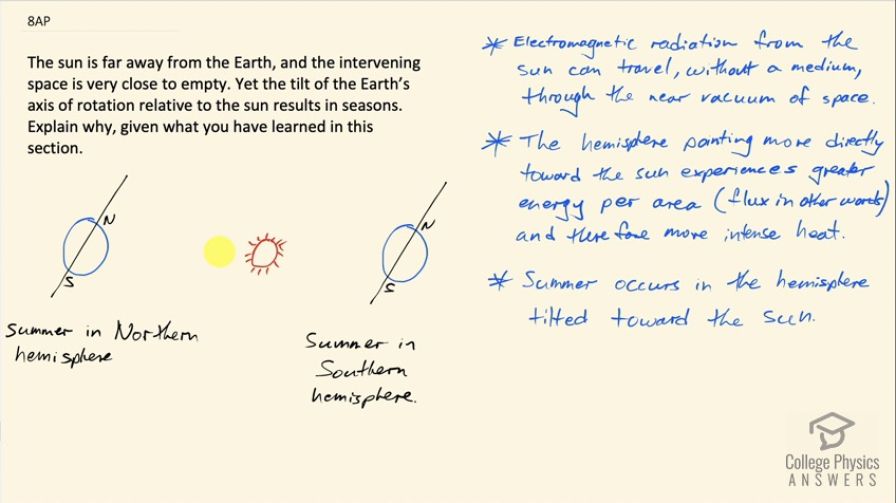Question
The sun is far away from the Earth, and the intervening space is very close to empty. Yet the tilt of the Earth’s axis of rotation relative to the sun results in seasons. Explain why, given what you have learned in this section.
Final Answer
Please see the solution video.
Solution video
OpenStax College Physics for AP® Courses, Chapter 24, Problem 8 (Test Prep for AP® Courses)

vote with a rating of
votes with an average rating of
.
Video Transcript
This is College Physics Answers with Shaun Dychko. The space between the Sun and the Earth is nearly empty—it's almost a vacuum— my drawing is not to scale by the way... the Sun can actually fit one million Earth's inside it the real Sun but this is not to scale. So the Earth is on this tilt 22.5 degrees with respect to the solar plane or a perpendicular to the solar plane I should say so this is the solar plane in which the Earth is orbiting and a perpendicular to it is at an angle makes an angle of 22.5 degrees with respect to the axis of rotation of the Earth so the Earth's axis of rotation is tilted. So on one side of the Sun this tilt will cause the northern hemisphere to be more directly pointing towards the Sun and that will cause an increase in intensity or an increased flux of solar radiation, there will be a greater energy per area in the northern hemisphere when the hemisphere is tilted towards the Sun. So electromagnetic radiation can travel through this vacuum because it does not require a medium— that's one thing that we learned in this chapter— and so we'll have greater flux in whatever hemisphere is pointing towards the Sun. Interestingly when it is summer in the northern hemisphere, which is where the United States and Canada are this is when the Earth is actually at a greater distance from the Sun but when the Earth is close to the Sun— I haven't really drawn that in this picture but when the Earth is close to the Sun, it's actually winter in the northern hemisphere. So it's this tilt that has the big effect on seasonality, not the distance from the Sun. Okay! So over here, we have a picture with the southern hemisphere Australia, New Zealand and Africa... well, part of Africa anyhow... the southern part... pointing towards the Sun and southern South America as well. So yes, summer occurs in the hemisphere that's tilted towards the Sun. There we go!